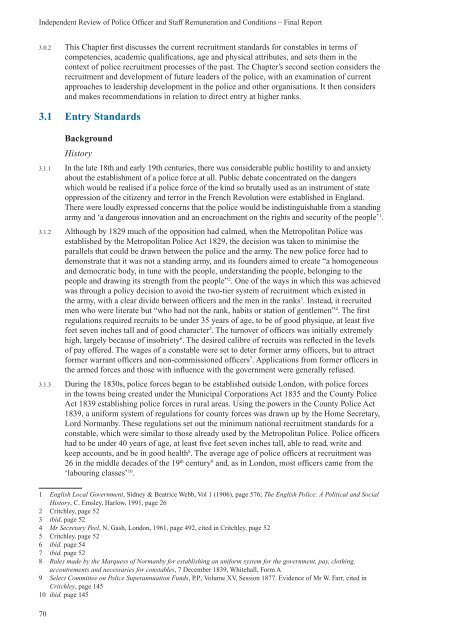Independent Review of Police Officer and Staff Remuneration and ...
Independent Review of Police Officer and Staff Remuneration and ...
Independent Review of Police Officer and Staff Remuneration and ...
You also want an ePaper? Increase the reach of your titles
YUMPU automatically turns print PDFs into web optimized ePapers that Google loves.
<strong>Independent</strong> <strong>Review</strong> <strong>of</strong> <strong>Police</strong> <strong>Officer</strong> <strong>and</strong> <strong>Staff</strong> <strong>Remuneration</strong> <strong>and</strong> Conditions – Final Report<br />
3.0.2 This Chapter first discusses the current recruitment st<strong>and</strong>ards for constables in terms <strong>of</strong><br />
competencies, academic qualifications, age <strong>and</strong> physical attributes, <strong>and</strong> sets them in the<br />
context <strong>of</strong> police recruitment processes <strong>of</strong> the past. The Chapter’s second section considers the<br />
recruitment <strong>and</strong> development <strong>of</strong> future leaders <strong>of</strong> the police, with an examination <strong>of</strong> current<br />
approaches to leadership development in the police <strong>and</strong> other organisations. It then considers<br />
<strong>and</strong> makes recommendations in relation to direct entry at higher ranks.<br />
3.1 Entry St<strong>and</strong>ards<br />
70<br />
Background<br />
History<br />
3.1.1 In the late 18th <strong>and</strong> early 19th centuries, there was considerable public hostility to <strong>and</strong> anxiety<br />
about the establishment <strong>of</strong> a police force at all. Public debate concentrated on the dangers<br />
which would be realised if a police force <strong>of</strong> the kind so brutally used as an instrument <strong>of</strong> state<br />
oppression <strong>of</strong> the citizenry <strong>and</strong> terror in the French Revolution were established in Engl<strong>and</strong>.<br />
There were loudly expressed concerns that the police would be indistinguishable from a st<strong>and</strong>ing<br />
army <strong>and</strong> ‘a dangerous innovation <strong>and</strong> an encroachment on the rights <strong>and</strong> security <strong>of</strong> the people’ 1 .<br />
3.1.2 Although by 1829 much <strong>of</strong> the opposition had calmed, when the Metropolitan <strong>Police</strong> was<br />
established by the Metropolitan <strong>Police</strong> Act 1829, the decision was taken to minimise the<br />
parallels that could be drawn between the police <strong>and</strong> the army. The new police force had to<br />
demonstrate that it was not a st<strong>and</strong>ing army, <strong>and</strong> its founders aimed to create “a homogeneous<br />
<strong>and</strong> democratic body, in tune with the people, underst<strong>and</strong>ing the people, belonging to the<br />
people <strong>and</strong> drawing its strength from the people” 2 . One <strong>of</strong> the ways in which this was achieved<br />
was through a policy decision to avoid the two-tier system <strong>of</strong> recruitment which existed in<br />
the army, with a clear divide between <strong>of</strong>ficers <strong>and</strong> the men in the ranks 3 . Instead, it recruited<br />
men who were literate but “who had not the rank, habits or station <strong>of</strong> gentlemen” 4 . The first<br />
regulations required recruits to be under 35 years <strong>of</strong> age, to be <strong>of</strong> good physique, at least five<br />
feet seven inches tall <strong>and</strong> <strong>of</strong> good character 5 . The turnover <strong>of</strong> <strong>of</strong>ficers was initially extremely<br />
high, largely because <strong>of</strong> insobriety 6 . The desired calibre <strong>of</strong> recruits was reflected in the levels<br />
<strong>of</strong> pay <strong>of</strong>fered. The wages <strong>of</strong> a constable were set to deter former army <strong>of</strong>ficers, but to attract<br />
former warrant <strong>of</strong>ficers <strong>and</strong> non-commissioned <strong>of</strong>ficers 7 . Applications from former <strong>of</strong>ficers in<br />
the armed forces <strong>and</strong> those with influence with the government were generally refused.<br />
3.1.3 During the 1830s, police forces began to be established outside London, with police forces<br />
in the towns being created under the Municipal Corporations Act 1835 <strong>and</strong> the County <strong>Police</strong><br />
Act 1839 establishing police forces in rural areas. Using the powers in the County <strong>Police</strong> Act<br />
1839, a uniform system <strong>of</strong> regulations for county forces was drawn up by the Home Secretary,<br />
Lord Normanby. These regulations set out the minimum national recruitment st<strong>and</strong>ards for a<br />
constable, which were similar to those already used by the Metropolitan <strong>Police</strong>. <strong>Police</strong> <strong>of</strong>ficers<br />
had to be under 40 years <strong>of</strong> age, at least five feet seven inches tall, able to read, write <strong>and</strong><br />
keep accounts, <strong>and</strong> be in good health 8 . The average age <strong>of</strong> police <strong>of</strong>ficers at recruitment was<br />
26 in the middle decades <strong>of</strong> the 19 th century 9 <strong>and</strong>, as in London, most <strong>of</strong>ficers came from the<br />
‘labouring classes’ 10 .<br />
1 English Local Government, Sidney & Beatrice Webb, Vol 1 (1906), page 576; The English <strong>Police</strong>: A Political <strong>and</strong> Social<br />
History, C. Emsley, Harlow, 1991, page 26<br />
2 Critchley, page 52<br />
3 ibid. page 52<br />
4 Mr Secretary Peel, N. Gash, London, 1961, page 492, cited in Critchley, page 52<br />
5 Critchley, page 52<br />
6 ibid. page 54<br />
7 ibid. page 52<br />
8 Rules made by the Marquess <strong>of</strong> Normanby for establishing an uniform system for the government, pay, clothing,<br />
accoutrements <strong>and</strong> necessaries for constables, 7 December 1839, Whitehall, Form A<br />
9 Select Committee on <strong>Police</strong> Superannuation Funds, P.P., Volume XV, Session 1877. Evidence <strong>of</strong> Mr W. Farr, cited in<br />
Critchley, page 145<br />
10 ibid. page 145

















